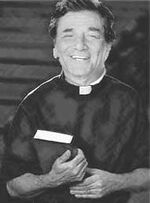St. Columbo

“One of our duller saints.”
St. Columbo was the sixth-century saint who discovered Ireland, Scotland, Blighty and Geneva. He is the patron saint of the Los Angeles Police Department, and his ministry has recently been immortalized on television in an inspirational series starring Peter Falk.
Formal training[edit]
Columbo was born (unsainted) in a convent/asylum in northern France, in the year five-something. Entering his career at an early age, as he had done his life, he studied theology at one of those dingy, Dark Ages universities.
Columbo revealed a talent for detective work, which led to a lucrative sideline in solving crime. In a typical workday, in which a crime occurs that is visible to everyone else, Columbo managed to identify the culprit and assemble evidence needed for an indictment, sometimes in barely ninety minutes, subtracting commercials. (It is not clear that these leaps of deduction were legitimate miracles that are the prerequisite for sainthood. But what happens in the Vatican, stays in the Vatican.)
Columbo's brother, Brother Cadfael, was also a crime-stopper. Surely, Cadfael could have won greater renown if not for the sojourn he took into the Crusades, but Columbo, though outwardly absent-minded, is regarded as one of the smartest people alive at the time (even though people were obviously not as smart back then).
Graduating from priest-school in record time, Father Columbo set off on a tour of his native France, in a dirty Peugeot convertible equipped with a police radio. He met sinners and the damned and saved an estimated 15% of them from the fiery pits of Hell. However, all this damnation disillusioned him, and he went to Spain to take up monastic vows. There he was demoted from Father to Brother and spent a lot of time illuminating manuscripts (a practice we would now call book-burning).
Discoverer of lands[edit]
In the monastery, Columbo learned that mankind had only discovered a small fraction of the world, and so he took it upon himself to find some of these undiscovered countries and claim them in the name of Jesus. These would include the Columbia River, the District of Columbia, Columbia Pictures, and, owing to a less-diligent scribe, Colombia.
Finally, he set off for the British Isles. They had, of course, been discovered much earlier by the Romans, but that was a long time ago and no one could remember that sort of thing, what with it being the Dark Ages and all. When he arrived, he was immediately attacked by snakes and Celts, neither of which were especially interested in Jesus. Fortunately, Columbo was a really good Catholic by now, and he soon taught them the error of their ways. With their help and now aided by a young Cornish lad named St. Cliff Richard (who would go on to become Britain's first native priest), he soon re-discovered the further away parts of Britain, opening a numbered bank account in each one.
One more thing: Columbo died in Scotland at the age of 43, having been bitten by a wild boar. He was survived by Mrs. Columbo.
Canonization[edit]
By the fifteenth century, Christianity was heading for a Reformation and running out of popular saints. The canonization of Columbo gave each nation a number of saints to claim as their own. In this way, people could reconnect with the religion that had brought them so much joy and comfort. Also, witches to burn on cold winter nights.
Columbo was chosen for this acclaim because of his importance in the history of the British Isles, which would be a lot smaller if he hadn't rediscovered large chunks of it. He is a minor patron saint of Spain, Scotland and Ireland, and a popular element of folk mythology in Blighty, not to mention Foggy Bottom.
